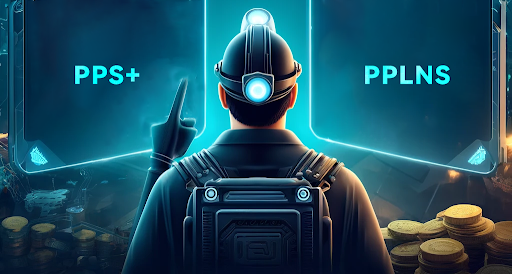Today, in PoW projects that support ASIC mining rig, the vast majority of miners tend to mine through mining pools such as Foundry USA, AntPool, or ViaBTC. The emergence of ASIC mining rigs has significantly increased the overall network’s hashrate. For miners with only a few mining devices, the probability of finding a block on their own is very low.
Mining pools aggregate the hashrate of miners from around the world, forming a formidable collective that facilitates easier resolution of hashing puzzles and enables the mining of numerous blocks in a short period. Rewards from these mined blocks are distributed among all miners participating in mining pool activities.
In some cases, some miners may connect 10 mining rigs to the mining pool, while other miners may only connect 1. How can this unequal contribution be fairly distributed in the mining pool for mining rewards?
To fairly distribute miners’ rewards, since the inception of the first mining pool in 2010, over 10 different payment models have emerged in the market. Nowadays, the mainstream payment models can be roughly categorized into 5 types: PPS, PPS+, PPLNS, FPPS, and SOLO. Among them, PPS+ and PPLNS are the two most commonly used payment models at present.
What is PPS+(Pay Per Share+)?
PPS+ is a payment model introduced by ViaBTC Pool in August 2016 as an improvement to the traditional PPS payment model. Based on PPS, PPS+ additionally allocates transaction fees. Specifically, coinbase rewards are distributed according to the PPS payment model, while transaction fees are distributed according to the PPLNS payment model (which will be discussed later).
In a mining pool, a share represents a possible solution to a hashing problem that miners submit to the mining pool, serving as proof of their contribution. The hashrate of a mining rig indicates the number of possible solutions it can generate per second. For instance, a mining rig with a hashrate of 200 TH/s can submit two quadrillion shares per second. Under the PPS payment model, miners receive rewards for each share they submit, regardless of whether the mining pool successfully mines a block.
Additionally, under the PPS+ payment model, extra transaction fees are allocated based on the transaction fees included in the blocks mined by the mining pool according to the PPLNS.
The core of this payment model lies in its stability and predictability. Regardless of fluctuations in the mining pool’s luck, miners can enjoy consistent mining income.
What is PPLNS (Pay Per Last N Shares)?
PPLNS is a payment model based on the most recent N shares. Miners’ earnings depend on the valid shares they contribute when the mining pool successfully mines a block.
Mining pools do not calculate the corresponding earnings immediately when miners submit possible solutions (share), but instead, after receiving every N shares, they tally the total rewards obtained by the mining pool from mining blocks during that period (including coinbase rewards and transaction fee rewards). Then, based on the proportion of shares submitted by each miner within these N shares, the rewards for that period are distributed.
For example, suppose a mining pool successfully mines a block after receiving N=200,000 shares. At this point, the mining pool immediately calculates the proportion of each participant’s shares within the last N shares. If Miner A contributed 200 shares out of these 200,000 shares, Miner A would receive a portion of the Coinbase reward as follows: 3.125 × 200 / 200,000 = 0.003125 BTC (excluding any fees deducted by the pool). Simultaneously, the transaction fees generated by this block would also be distributed based on Miner A’s share contribution.
Compared to PPS+, the PPLNS payment model is more volatile, with mining rewards for miners potentially being either high or low.
How to Choose the Best Payment Model?
Regardless of which mining pool a miner chooses to join, they must first set the payment model before the mining rig starts operating. So, how do you choose the most suitable payment model for yourself? The premise is to understand the advantages and disadvantages of each model. Here’s a summary:
Preference for stable income miners: If you value income stability and predictability more, PPS+ might be the more suitable choice. PPS+ can provide a continuous fixed return, suitable for miners who are unwilling to take on significant risks.
Miners willing to take risks for higher returns: If you can tolerate income fluctuations and seek higher potential returns through mining, then PPLNS may be more suitable for you. PPLNS can yield higher rewards when blocks are successfully mined, suitable for miners willing to commit long-term and have confidence in the mining pool.
Mainstream cryptos and their associated payment models that major mining pools
The entities chosen are: AntPool, ViaBTC, F2Pool, Binance Pool, and EMCDPool.
ViaBTC has recently implemented the PPS+ payment model in the KAS mining pool, providing KAS miners who join the ViaBTC Pool with the option to select PPS+ as their payment mode.
About ViaBTC
ViaBTC, founded in May 2016, has provided professional, efficient, safe and stable crypto mining services for over one million users in 130+ countries/regions around the world, with a cumulative mining output value of tens of billions of dollars. This world-leading, all-inclusive mining pool offers mining services spanning more than ten mainstream cryptos that include BTC, LTC, and KAS. Backed by one-stop services covering ViaBTC Pool, CoinEx Exchange, and CoinEx Wallet, ViaBTC strives to offer global users more supporting tools, stabler and more efficient mining services, as well as better product experience.
Disclaimer: The text above is an advertorial article that is not part of Cryptonews.com editorial content.
Read the full article here

